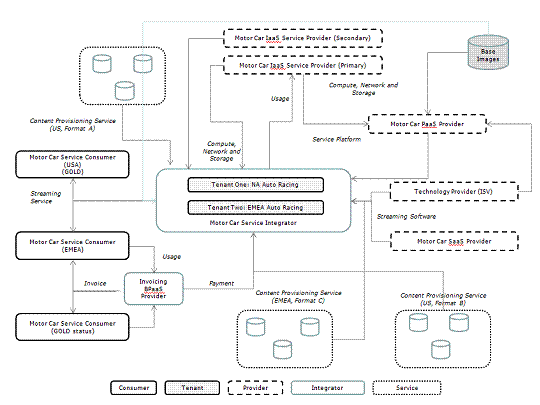Service-Oriented Cloud Computing Infrastructure (SOCCI) Framework – Case Study of Cloud-Based SOI – Motorcars in the Cloud
 A Cloud Service Integrator (CSI) has built an online environment to stream live events, timings, and scorings as well as providing images for auto race videos from as far back as 1909 to Cloud Service Consumers (CSC) (Motor Car enthusiasts). The CSI is providing this environment by leveraging Cloud Service Providers (CSP) for infrastructure, platform, and software services along with a third-party Independent Software Vendor (ISV) who provides the streaming software.
A Cloud Service Integrator (CSI) has built an online environment to stream live events, timings, and scorings as well as providing images for auto race videos from as far back as 1909 to Cloud Service Consumers (CSC) (Motor Car enthusiasts). The CSI is providing this environment by leveraging Cloud Service Providers (CSP) for infrastructure, platform, and software services along with a third-party Independent Software Vendor (ISV) who provides the streaming software.
The online environment is enabled by several services – some of which are provided by the CSPs while others are provided by the CSI themselves. A key service provided by the CSI is the streaming video of content from previous years that is housed in multiple storage clouds in different formats. The CSC gets billed based upon the payment options agreed by the CSI or by the CSP directly.
The CSI provides this service for multiple auto-race event organizers (e.g., North American Auto Racing Company, EMEA (Europe, the Middle East, and Africa) Auto Racing Company, etc.) while respecting the security and performance considerations specific to each tenant.
A CSC accesses a portal using a standard web browser to views races from yester years through streaming video which can be executed on a workstation, cell phone, or other appliance.
The CSI ensures that they meet contractual agreements with the CSC by providing an environment on which the CSP can provide their services.
The CSI leverages the appropriate CSP services as needed to deliver the content to the CSC.
The various building blocks outlined earlier manifest themselves in this scenario as described below. Some of these building blocks could be used globally by all service providers, whereas others are local to a given service provider as indicated within parentheses below.
Virtualization Manager (Global)
The IaaS provider needs this emulator to provision virtualized environments that emulate the right kind of infrastructure with the requisite resources in alignment with the SLAs established between cloud consumer and cloud provider or cloud integrator.
Location Manager (Global)
One of the tenants being hosted in this environment is paying additional charges for an organization license to have controlled private access to their videos. There is a sudden spike in demand for viewing auto-racing videos over the summer from EMEA users. Videos include those from both tenants. The Location Manager has to ensure that additional storage is provisioned to store these videos in compliance with EMEA federal regulations while respecting the contractual agreements with both tenants, including the privacy access policies for the premium tenant.

“Motorcars in the Cloud” Case Study
“Motorcars in the Cloud” Case Study shows the business scenario representing the Motorcars in the Cloud Case Study. The following sections detail the manner in which the various building blocks outlined earlier in SOCCI Architecture Building Blocks manifest themselves in this scenario.
Provisioning Manager (Local)
Sudden surge in demand results in the Event and Capacity Monitoring & Event Manager detecting the thresholds being reached triggering the Capacity & Performance Manager to evaluate the quantity of additional resources required. Based upon the Capacity & Performance Manager’s evaluation, the Provisioning Manager allocates additional resources for server, network, and storage to the CSI and the PaaS provider. Network is reconfigured to accommodate quality of service levels, which requires reconfiguring the network to match the load and the streaming bandwidth. When the demand is restored to normal levels, the Provisioning Manager is triggered through a similar chain of events to de-allocate the resources allocated earlier.
Capacity & Performance Manager (Local)
Capacity & Performance Manager evaluates the quantity of additional resources required at any point in time. The resources thus identified are made available for allocation by the Provisioning Manager. Capacity & Performance Managers are typically local to a given service provider. Global Capacity & Performance Managers are not practical across the different service providers. Therefore, SLAs are essential between the various service providers that ensure that the right number of resources is allocated at the right time by each service provider. Charges for consumption of the resources could have a fixed and variable component. In order to address a sudden spike in demand that may not be met by the CSP, the CSI needs to ensure that there are fallback plans in place – perhaps with multiple IaaS providers – to ensure that the platform can still be continued to be provisioned to the CSC. Manages resources across multiple tenants (North American Auto Racing Company and EMEA Auto Racing Company) based upon the contractual agreements and policies in place.
Metering Manager (Global)
Metering is employed by various service providers to track and consolidate the usage of server, network, storage, and facilities resources by service consumers. In this scenario, for example, the IaaS service provider tracks the usage of such resources by the CSI. The CSI, in turn, would track the usage patterns for these resources by tenant.
Billing Manager (Local)
Billing Manager determines and charges the appropriate portion of the cost to specific consumers based upon their pattern of resource consumption as determined by the metering aggregator. This is applicable in the context of the multi-tenant environment that the CSI hosts in this scenario. The CSI determines the charges for each tenant based upon the cost provided by the Billing Manager.
Monitoring & Event Manager (Local)
Event and Capacity Monitoring & Event Manager continually tracks the infrastructure capacity consumed, triggering a notification to the Capacity & Performance Manager when predefined thresholds are reached. Like Capacity & Performance Managers, Event and Capacity Monitoring & Event Managers are also local to the service providers. Event and Capacity Monitoring & Event Manager could be global if there are well-established standards for exchange of information between multiple service consumers and service integrators.
Configuration Manager – (Global)
PaaS provider maintains multiple versions of the virtualization templates of the images to be provisioned. Configuration Manager enables the consistent maintenance and version control of these templates in alignment with the requirements specific to the tenant, geography, and service-level expectations.